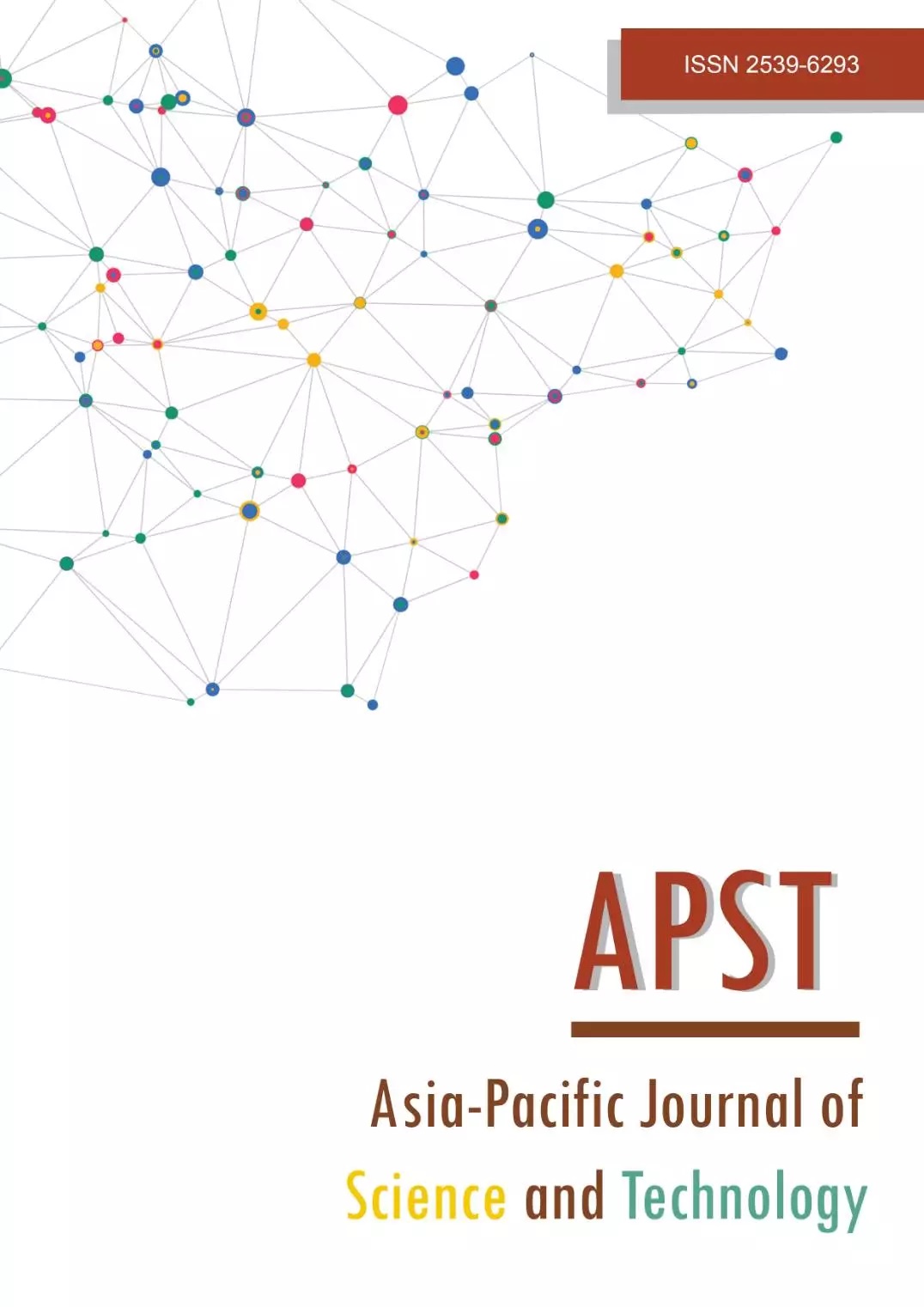Organic fertilizers supplemented with rhizobacteria for promoting the growth of rice (Oryza sativa L.)
Main Article Content
Abstract
The effects of organic fertilizer supplemented with halotolerant rhizobacteria on rice growth were investigated. Immobilization of halotolerant rhizobacteria on various carriers was performed. The results showed that filter cake was the best carrier supporting microbial cell survival of 109 colony-forming unit per gram (CFU/g). The amounts of nutrients were not different during composting except for phosphorus levels which increased from 0.8-1.13% to 2.17-3.23% at the maturation phase. The germination index of rice seeds in the presence of extracts from the three compost formulas was greater than 80%, indicating the maturity of this compost. The results from pot experiments showed that organic fertilizers supplemented with the mixture of three isolates of halotolerant rhizobacteria formulation 1 (FC), a combination of filter cake and spent wash, and formulation 3 (FC+B), filter cake, spent wash and bagasse supplemented with chemical fertilizer, best promoted the highest plant growth parameters. Three halotolerant rhizobacteria, namely Pseudomonas azotoformans I2.1 Enterobacter aerogenes P8 and Bacillus tequilensis N15 were successfully used in combination with the inoculants to supplement an organic fertilizer. They could potentially promote the germination of rice seeds and the growth of rice plants in pot experiments.
Article Details

This work is licensed under a Creative Commons Attribution-NonCommercial-NoDerivatives 4.0 International License.
References
Land and Water Division. Prognosis of salinity and alkalinity. 1st ed. Rome: FAO. 1976.
Grattan SR, Oster JD. Use and reuse of saline-sodic water for irrigation of crops. J Crop Pord. 2003;7(1-2):131-162.
Rocha GJM, Martin C, Soares IB, Maior SAM, Baudel HM, Moraes CA. Dilute mixed-acid pretreatment of sugarcane bagasse for the ethanol production. Biomass Bioenergy. 2011;35(1):663-670.
Baig TT, Sheikh MA, Hamee A. Bioconversion of filter press cake (mud) of sugar-cane to biomass protein and its biological evaluation. Pak J Biol Sci. 2002;5(10):1052-1055.
Kremer RJ, Peterson HL. Effects of carrier and temperature on survival of Rhizobiums spp. in legume inocula: development of an improved type of inoculant. Appl Environ Microbiol. 1983;45(6):1790-1794.
Bashan Y. Inoculants of plant growth promoting bacteria for use in agriculture. Biotechnol Adv. 1998;16(4):729-770.
Sarin P, Boonlue S, Riddech N. Isolation of halotolelant rhizobacteria from saline soil and their effect on rice seed germination. Asian J Microbiol Biotechnol Environ Sci. 2014;16(4):867-876.
Meunchang S, Panichsakpatana S, Weaver RW. Co-composting of filter cake and bagasse; by-products from a sugar mill. Bioresour Technol. 2005;96(4):437-442.
Subba R. Soil microorganisms and plant growth. 3rd ed. New Dehil: Oxford and IBH Publishing Co.; 1977.
Patil AS, Mahamuni SV, Wani PV. Isolation of phosphate solubilizing fungi from rhizosphere of sugarcane and sugar beet using Tcp and Rp solubilization. AJBPR. 2012;1(2):237-244.
Xu J, Yang Q. Isolation and characterization of rice straw degrading Streptomyces griseorubens C-5. Biodegradation. 2010;21(1):107-116.
Barral MT, Paradelo R. A review on the use of phytotoxicity as a compost quality indicator. Dyn Soil Dyn Plant. 2011;5(2):36-42.
Bates L, Waldren RP, Teare ID. Rapid determination of free proline for water-stress studies. Plant Soil. 1973;39:205-207.
Hernández AR, Prado RDM, González LC, Gustavo C, Leandro RM, Luis CA, et al. Phosphorus sources enriched with filter cake and microorganisms in the soil microbiota: phosphorus absorption and sugar cane dry matter production. Cienc Investig Agrar. 2015;42(2):295-303.
Chemining’wa GN, Vessey KJ. The abundance and efficacy of Rhizobium leguminosarum bv. viciae in cultivated soils of the Eastern Canadian prairie. Soil Biol Biochem. 2006;38:294-302.
Brockwell J, Bottomley PJ. Recent advances in inoculants technology and prospects for the future. Soil Biol Biochem. 1995;27(4-5):683-687.
Stephens JH, Rask HM. Inoculant production and formulation. Field Crops Res. 2000;65(2-3):249-258.
Honig P. Principles of sugar technology, 1st ed. Amsterdam: Elsevier press; 1953.
Devi V, Sumathy VJH. Production of biofertilizer from fruit wastes. Eur J Pharm Med Res. 2017;4(9):436-443.
Monson CC, Murugappan A. Developing optimal combination of bulking agents in an in-vessel composting of vegetable waste. E-J Chem. 2010:7(1):93-100.
Boodoosingh R, Swan C, Desmarais AM, Beckles DM. The effect of bulking agent and initial contaminant concentration on the biodegradation of total petroleum hydrocarbons. In: Kostecki PT, Calabrese EJ, Dragun J, editors. The Annual International Conference on Soils, Sediments, Water and Energy; 2010 Oct 18-21; Massachusetts, USA. California; Bepress; 2010. p.219-226.
Mahfouz SA, Eldin SMA. Effect of mineral vs. biofertilizer on growth, yield, and essential oil content of fennel (Foeniculum vulgare Mill.). Int Agrophys. 2007;21(4):361-366.
Mengel K, Kirkby EA. Principles of plant nutrition. 5th ed. Berin: Srpinger; 2001.
Takagi H. Proline as a stress protectant in yeast: physiological functions, metabolic regulations and biotechnological applications. Appl Microbiol Biotechnol. 2008;81(2):211-223.
Ueda A, Takabe YYT. Salt stress enhances proline utilization in the apical region of barley roots. Biochem Biophys Res Commun. 2007;355(1-3):61-66.
Lakhdara A, Rabhia M, Ghnaya AT, Montemurroc F, Jedidi N, Abdellya C. Effectiveness of compost use in salt-affected soil. J Hazard Mater. 2009;171(1-3):29-37.


